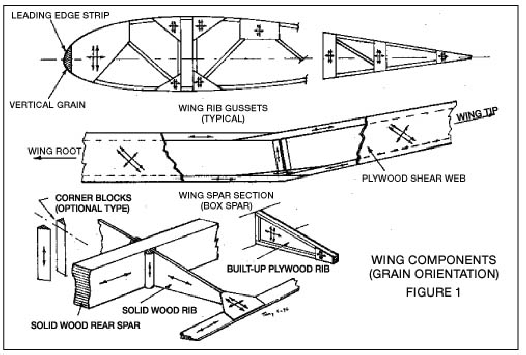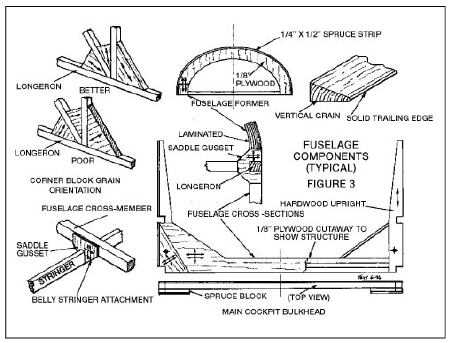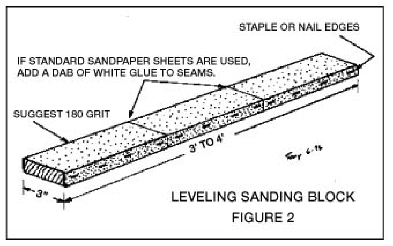Aircraft Woodwork Basics
By Tony Bingelis (originally published in EAA Sport Aviation, September 1996)
Recently, my computer allowed me to stumble onto some online chitchat about homebuilt aircraft, wood, glues, designs to build and stuff like that. I was interested, and quite pleased to find the stuff because I seldom have much control over what my computer decides to do.
However, I did feel like a Peeping Tom looking in on the conversations of strangers with them blissfully unaware as to who was reading their opinionated words of wisdom.
The familiar topics being discussed piqued my interest for a while until it became apparent to me that the basic information being passed around was sporadic and seldom developed in detail. Technical accuracy usually suffered because of that.
I will probably be inviting contempt and possibly sarcasm from computer oriented builders and addicts, but I must say, in my opinion, the so-called "information super highway" to worthwhile practical information for the average homebuilder simply is not there, yet.
That highway may have been engineered but it is still under construction and has yet to be paved. Give me a good set of plans, a technical article, a "How-To-Do" book, or even a video anytime.
Any of those options, for me as a builder, would be far more practical and cheaper than the precious hours spent online hopefully scrolling for useful information.
New Topic
Although much information has been printed in Sport Aviation and other EAA publications regarding the construction of wood aircraft, many of the letters I receive continue to raise basic questions similar to those I read online. There is uncertainty over the selection and use of acceptable glues and adhesives. In addition, questions regarding woodworking practices, in general, also seem to crop up.
This is understandable since many new builders and new EAA members who have joined the scene in the past few years have not had access to previous writings and older EAA publications.
It seems that most of the new builders and would-be builders who write me are very interested in building some kind of wood aircraft from plans.
The most frequently cited reason for their motivation is one of economics . . . that is, they say they cannot honestly justify the purchase of an expensive kit for a homemade airplane.
At the same time, many of them point out that they are comfortable working with wood and express the desire to get started with some simple plans-built wood design to gain experience. They go on to say they would then be better prepared to build their dream airplane later.
I will, therefore, let this article serve as an open letter to briefly answer a few select woodworking questions these builders have raised.
What Glue?
Most glues used by homebuilders require curing temperatures of 70°F and above in order to produce reliable joints. One exception is T-88 epoxy. It will cure, although somewhat slower, in temperatures as low as 35°F. This makes T-88 an ideal choice for builders who have to work in colder climates.
As a builder you will be faced with quite a few options when selecting a glue for your project. Your first choice, and it would probably be an excellent one, is to use the glue recommended by the designer. If there is no such recommendation most any of the glues listed in your aircraft supply catalogs would be O.K. to use (read the descriptive summary for each glue before you make your pick).
Some glues are easier to work with than others. For example, glues that require an odd ratio mix of a resin and catalyst can be tricky to mix in small quantities.
Ideally, a 1:1 mix is as close to being foolproof as you can get. A couple of good adhesives using this mix are T-88 epoxy and APCP Structural Adhesive.
Other popular glues include:
1. Resorcinol (Weldwood, Borden, etc.) . . . an excellent two-part waterproof glue. Mix by weight is 4 parts liquid to 1 part powder. Resorcinol glues require excellent joints and considerable clamping pressure to ensure good joints. Temperatures must be above 70° for a reliable cure. It is considered to be the most durable and best proven glue in the world.
2. FPL-16A . . . a 10:1 mix epoxy . . . tricky to mix in small amounts. (Since it is a white glue an inspector might mistake it for an unacceptable white carpenter’s glue.)
3. Urea-formaldehyde glues have lost favor in Australia. These include:
a. Aerolite, a urea-formaldehyde resin. Good but tricky to use. The British built bombers using this glue in WW-II. Mix powder with water to form paste. Apply paste to one surface and brush on a catalyst hardener on the other surface. If you forget to brush on the catalyst you may never realize it until a joint fails later.
b. Plastic Resin (Weldwood, etc.) is also a urea-formaldehyde glue.
This tan colored powder when mixed with water is ready for use. This has long been considered to be a good, easy to use glue, but it is only water resistant, not waterproof. It is the least expensive glue and is available in many hardware stores. Plastic resin glue has been widely used in thousands of homebuilts like the Fly Baby and Pietenpol.
Unfortunately, as seems to be the rule lately, familiar old products are often "discovered" to be suspect and "no good no more." So it is with Aerolite and plastic resin.
First it was Australia’s CAA that determined acid catalyzed phenolic (ACP) or urea formaldehyde (UF) glues (as a class) should not be used in powered homebuilt aircraft because structural failure of ACP glue joints has been the cause of several accidents.
The circumstantial evidence against plastic resin is not as strong although it is known that it too reacts chemically to changes in humidity and their long term durability under outdoor climatic conditions is suspect.
Anyhow, now it seems that the FAA will agree with Australia that the glue should not be used in homebuilt aircraft because it could deteriorate badly in hot, humid climates. Therefore, if you want to use either urea formaldehyde glue in your project, check with your local FAA office to determine their current attitude about the glues use.
Recent letters like the following one point up the quandary that exists in the minds of aspiring builders of wood aircraft.
"My problem is in deciding what glue to use (he’s building a Boredom Fighter). Many local builders swear by T-88, so I purchased some. I was surprised to read on the label that glued parts should not be used above 150°F. I can sure see the inside of the airplane, especially the wings, if painted a dark color, getting pretty hot in the summer. I also read a recent article in Sport Aviation that sounded a bit negative concerning epoxy glues in general. I sure like working with T-88 and would be very interested in hearing what your thoughts are."
I told him of two Boredom Fighters that were built locally several years ago. They were assembled with T-88 epoxy and plain ol’ Weldwood Plastic Resin glue. The plastic resin was used for building the wing ribs and attaching gussets and small parts. The major structural components were assembled using T-88.
One plane has since been sold and now resides in California (not a cold climate). The other remains in Texas enjoying frequent 100° summer weather. Both aircraft are doing fine, thank you.
I think epoxy adhesives are remarkable glues. Quite a few of them are used in the construction of a variety of aircraft, including composites, wood and mixed construction.
These glues are cohesive and tough, and adhere tenaciously to most materials. Good reliable joints usually result even with poorly fitted parts and very little clamping pressure. However, they, like other glues, have their drawbacks.
Epoxies, in general, are expensive and can be fairly toxic if used carelessly. A number of builders will surely suffer from skin rash and worse due to its use. Working in poorly ventilated enclosed areas is to be avoided.
NOTE: Epoxies that most builders use cure at room temperatures and epoxied structures are generally sensitive to heat. That is, they tend to soften (weaken) with higher temperatures.
As cited above, T-88 begins to soften at temperatures above 150°F. Notice I said "soften," and not "comes apart."
With that dumb observation still in mind, I recall a builder who wrote how he screwed up part of his T-88 assembled tail structure. He tried to take it apart using his wife’s hair dryer, a sun lamp, a heat lamp, etc. All he succeeded in doing was charring the wood, the structure remained intact, so he said.
Anyway, the decision is yours.
Whatever glue you use, I suggest making test samples of each batch used and later demolish them with a hammer to see if the glue joint separates or the wood fibers fail. The wood fibers should fail, not the glue line.
Grain Orientation
This is another area of uncertainty for some builders. The grain orientation in wood parts, plywood webs, gussets and the like is important especially in components like wing spars and other highly stressed locations.
Usually, the designer will indicate on the drawings the preferred orientation of the surface grain. However, if that information is not depicted consider the merits of the following:
In general, plywood bends easier along the direction of the surface grain. This is because three layer plywood will have the grain of the two surface plies running in the same direction. Only the center ply will be oriented in a crosswise direction. It is, therefore, sometimes called 90° plywood.
Plywood whose surface grain runs at an angle is termed 45° plywood. Because of its grain orientation it is stiffer and doesn’t bend easily in any direction. It is more expensive but only slightly stronger than ordinary 90° plywood.

Forty-five degree plywood is used for box spars and wing and fuselage skins where stiffness is important. It is less likely to show signs of bulging or sagging between ribs and uprights due to changes in humidity - an annoying cosmetic condition that does not affect the plywood’s serviceability.
In general, plywood is somewhat stronger along its external grain direction. This is taken into consideration when fitting and attaching gussets and plywood webs to wing ribs and other structure.
Grain orientation in solid wood parts is equally important and can affect the strength of a glued assembly.
Keep in mind the fact that when joining (gluing) two solid wood pieces together, the strongest joint results when the grain in each part is more or less parallel.
When the grain in one piece doesn’t parallel the other part, more end grain, is introduced in the joint and a weaker joint results.
Obviously, the weakest type of joint is an unreinforced butt joint. For example, trying to glue an upright against a longeron always results in a weak aircraft joint that must be reinforced with corner blocks or plywood gussets (see Figure 3).

Box spars are enclosed by gluing plywood shear webs to each side of the solid wood structure.
This plywood web is generally laid on with the grain oriented at a 45° angle to the span. There is some difference of opinion as to the most effective grain direction.
An old government publication (ANC-19), long out of print, was accepted as an authoritative source for fabricating wood aircraft. It recommends that 45° plywood shear webs on a box spar or I beam
spar have the grain oriented in the direction which will provide stiffening against buckling due to compression loads. In effect, this means the face grain in the plywood would run from the bottom outward to the top inboard of the spar.
They go on to say that if 45° plywood is used it could result in a structure five times stiffer although only slightly stronger.
However, it is conceded that the spar webs are often laid on with the face grain perpendicular to the long axis of the spar simply because there is little or no reduction in strength and because of cost considerations.
You will find in most wood designs the plywood shear webs on stabilizer, elevator, fin and rudder spars, to be oriented at 90° to their center lines.
Line Sanding and Profiling
When a wooden wing structure is to be plywood covered its underlying frame usually has to be trued and profiled so that the plywood will contact each rib and wood part smoothly without causing bulges or sags in the plywood skin. Because all of the ribs come from the same rib jig(s), very little profiling will be necessary.

A longstanding practice is to use a long sanding block (3’ or 4’ in length) that spans at least three ribs to "line-sand" the ribs in an assembled wing structure in order to level any high spots.
NOTE: After wing ribs have been built, some builders assemble all of the ribs on a short dummy spar and line-sand them to a uniform profile. This is not a good practice. Here’s why. Later, when you assemble the wing structure, slight vertical rib misalignments may occur and a second line-sanding will be necessary. Unfortunately, this will remove even more of the rib’s capstrip weakening it, and possibly altering the wing’s aerodynamic shape. Therefore, resist the impulse to line-sand the ribs until the wing is finally assembled and you are readying it for the installation of the plywood skins. Use a rather fine grit for the sanding block as very little material will have to be removed. A sanded soft wood surface in preparation for gluing is considered to be inferior to a smoothly planed one but those amazing epoxies don’t know the difference.
